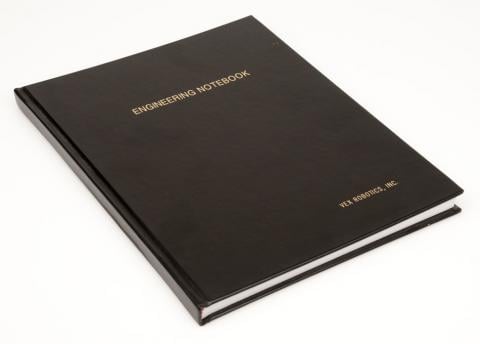When solving a problem, almost everyone follows a process similar to the one outlined above, even if they only do it subconsciously. Every time they are asked to make a decision, they run through this process without even realizing it. The design process can be accomplished with varying degrees of formality, ranging from the subconscious process everyone does in their head to the highly documented process used in corporate engineering.
Designers must determine what degree of detail and documentation is needed for their specific process. Many designers are tempted to do everything in their head, thinking that documentation will only slow them down. In truth, a more formalized process will produce a better result. Formalization will promote thoroughness; additional documentation will help prevent mistakes.
In competition robotics it is useful to keep documentation of the design, though the extent of this documentation is sometimes limited by the time available. However, as described above a documented process is a more methodical process. The notes can also be useful when explaining the design to competition judges and they will serve as good documentation for future team members who want to understand the process used.
For the purposes of this class, students should document almost everything in their engineering notebooks.
Engineering Notebooks
An Engineering Notebook is a record of the design process; it is basically a “diary” that designers keep as they progress through the process.
Engineering Notebooks come in many different formats, but they should detail each step of the process. They should combine a narrative of the progress, concept sketches, engineering calculations, pictures of prototypes, test procedures, and more. Some of the most important things to record are the decisions made, and the reasoning behind these decisions. Later on in the design process, if a designer runs into a problem and does not remember why something was done a certain way, the notebook will provide a good reference. A Design Notebook should serve as a roadmap such that any outsider can follow the designer’s process, understand the choices made by the designer, and end up with the same result.
If a designer gets transferred to a different team in the middle of a project, someone else should be able to read his or her Engineering Notebook and pick up right where they left off.
Every notebook entry should be dated and signed by the designer to provide proof of when the documented work was done; this comes in handy during any patent or intellectual property debates that occur over the design (obviously this typically doesn’t apply to the work done by competition robotics teams).
ENGINEERING TOOLS:
Engineers use a variety of tools to help them during the completion of a design process and the solving of a problem. One of these tools is the Engineering Notebook, which was described previously. Engineers often also use something called Computer Aided Design (CAD) software to help them in the virtual creation and visualization of their designs. One industry leading CAD program, which will be used by students in this class, is Autodesk® Inventor®.
Autodesk Inventor Professional
Autodesk® Inventor® Professional simplifies the transition from 2D and 3D mechanical design, using intuitive sketching, direct manipulation, product simulation, and design communication. Inventor takes you beyond 3D to Digital Prototyping by enabling a designer to produce an accurate 3D model that can help with the design, visualization, and simulation of the robot before it’s built. Digital Prototyping with Inventor will help students design a winning robot, by guiding them through assembly creation and ensuring that all parts and components fit correctly.
Another program which will support the design of a competition robot is Autodesk ForceEffect.
ForceEffect & ForceEffect Motion
Autodesk® ForceEffect and ForceEffect Motion™ engineering apps are purpose-built tools used to quickly and easily simulate design options. ForceEffect enables students to perform static systems analysis using free body diagrams. ForceEffect Motion is ideal for developing mechanical systems with moving parts. Unlike the traditional approach of using paper, pencil, and a calculator to develop equations for design options, Autodesk ForceEffect and ForceEffect Motion do all the simulation and engineering calculations right on your mobile device, enabling designers to quickly and easily simulate options during the concept phase to determine if a design will work.
CONCLUSION:
As seen in this unit, Engineering and the Engineering Design process are both integral to the development of competition robots. Students will gain practical knowledge in topics related to robotics, and apply them using the engineering design process to design their competition robot.

